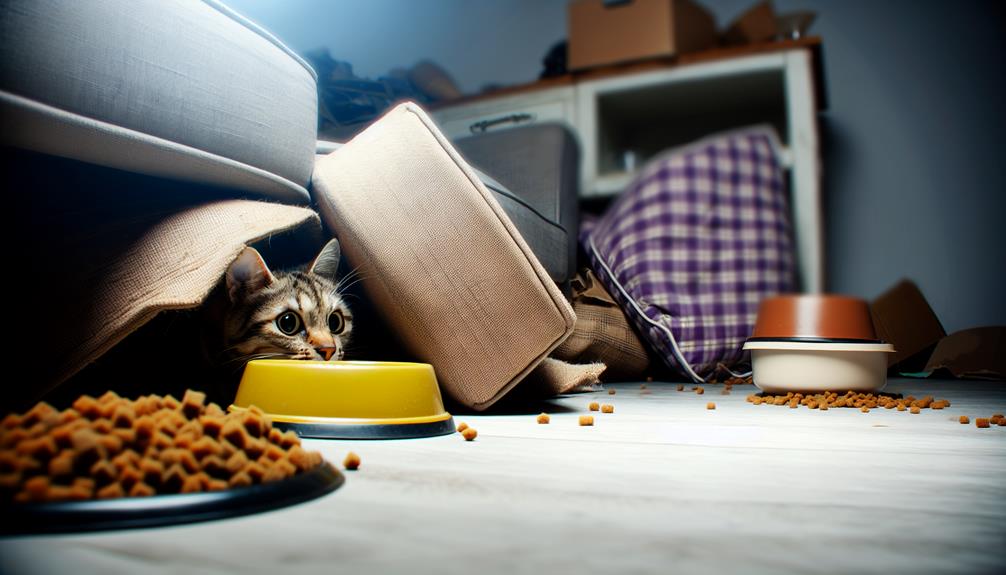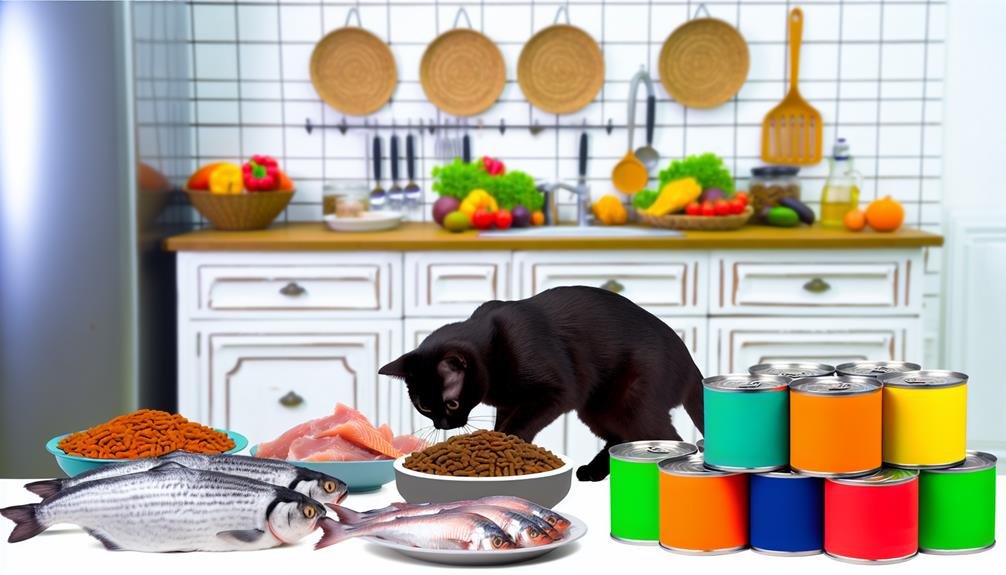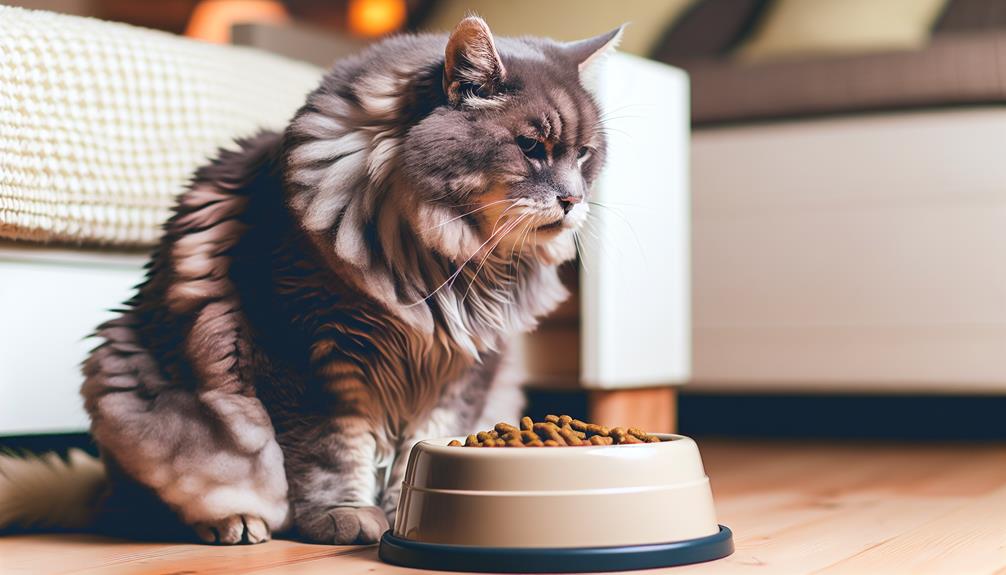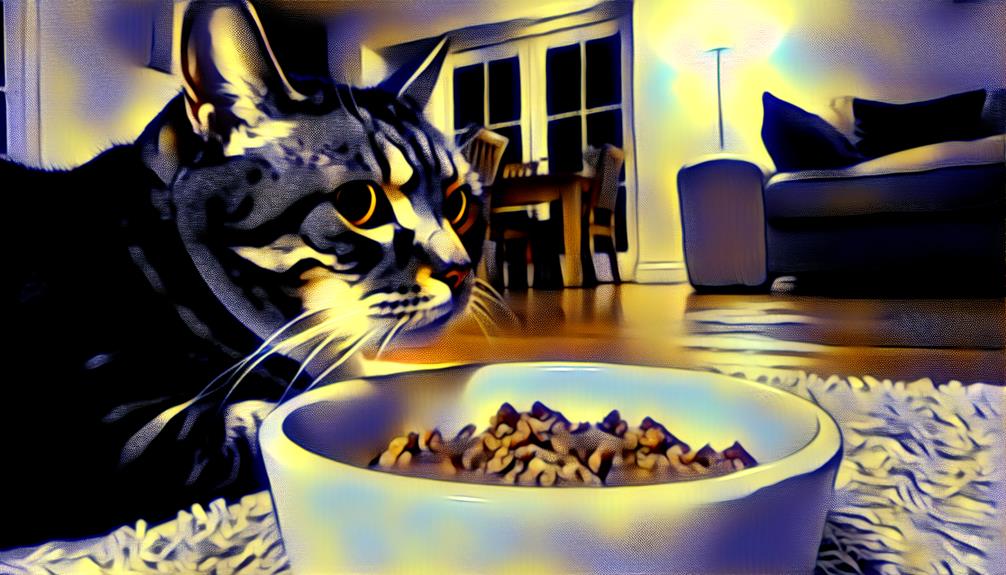Have you ever wondered if your cat's sudden lack of appetite could be linked to a hidden health issue? It's possible that dental problems or gastrointestinal disorders are playing a role. Stress factors like environmental changes or your absence might also contribute. Even aging can bring about appetite changes due to chronic conditions or psychological factors. Understanding these possibilities is key to ensuring your feline friend's well-being. Let's explore what might be causing your cat's reluctance to eat and consider the steps you can take to address this concern effectively.
Health Issues
Health issues can often be the primary reason your cat isn't eating. When a cat refuses food, it's vital to evaluate underlying health conditions that might be affecting its appetite. One significant factor can be hormonal imbalances. Diseases like hyperthyroidism can cause a spike in metabolism, leading to weight loss despite a normal or increased food intake. Conversely, conditions like hypothyroidism can reduce appetite and cause lethargy, making your cat disinterested in food.
Another health issue to evaluate is gastrointestinal disorders. Cats can suffer from a range of gastrointestinal problems, such as inflammatory bowel disease (IBD) or pancreatitis, which can result in a lack of appetite. Symptoms of these disorders often include vomiting, diarrhea, and abdominal pain, all of which can discourage a cat from eating. In more severe cases, gastrointestinal obstructions caused by ingested foreign objects can also lead to a sudden drop in appetite and require immediate veterinary intervention.
Additionally, chronic kidney disease (CKD) is a common ailment in older cats that can affect their willingness to eat. CKD leads to the buildup of toxins in the bloodstream, causing nausea and a decreased appetite. Similarly, liver disease can lead to anorexia in cats due to the liver's essential role in metabolism and detoxification.
Identifying and addressing these health issues is fundamental for restoring your cat's appetite and overall well-being. If you suspect that hormonal imbalances or gastrointestinal disorders are the culprits, consult your veterinarian for a thorough examination and appropriate treatment options.
Dental Problems
Dental problems can greatly impact your cat's appetite. Tooth pain, gum disease, and broken or lost teeth are common issues that may cause discomfort and lead to decreased food intake. It's essential to monitor your cat for signs of oral health problems to guarantee timely treatment and maintain their overall well-being.
Tooth Pain Issues
Why might your cat suddenly refuse its favorite meal? One possible reason could be tooth pain issues. Dental problems are common in cats and can lead to considerable discomfort, causing them to avoid eating. Poor oral hygiene may lead to conditions that necessitate tooth extraction, a procedure often required to alleviate severe pain and infection.
Maintaining your cat's oral hygiene is vital. Regular brushing, dental chews, and professional cleanings can prevent the buildup of plaque and tartar, which are primary culprits in causing dental pain. If your cat is already showing signs of discomfort, such as drooling, pawing at the mouth, or bad breath, it's important to consult a veterinarian promptly.
Here's a quick overview of the issues and possible interventions:
| Issue | Intervention |
|---|---|
| Tooth decay | Professional cleaning |
| Broken tooth | Tooth extraction |
| Plaque buildup | Regular brushing |
| Tartar accumulation | Dental chews |
| Oral infection | Antibiotics and cleaning |
Timely veterinary intervention can greatly improve your cat's quality of life. Ignoring these signs can lead to more severe complications. Cats rely heavily on their teeth for eating and grooming, making dental health a fundamental aspect of their overall well-being.
Gum Disease Symptoms
Gum disease, also known as periodontal disease, can be a silent yet serious ailment in cats. If your cat stops eating, gum disease might be to blame. Poor oral hygiene can lead to gum inflammation, causing pain that deters your cat from eating. Recognizing the symptoms early can prevent severe complications and guarantee your cat's well-being.
Here are three key symptoms to watch for:
- Red and Swollen Gums: Gum inflammation is a primary indicator. Healthy gums should be pink; any redness or swelling is a red flag.
- Bad Breath: While occasional bad breath is normal, persistent foul odor could signify underlying dental issues.
- Drooling or Difficulty Eating: If your cat starts drooling excessively or seems to struggle while eating, it might be due to gum discomfort or pain.
Maintaining good oral hygiene is essential in preventing gum disease. Regularly check your cat's mouth for any signs of inflammation or discomfort. If you notice any of these symptoms, consult your veterinarian promptly. Early intervention can mitigate the progression of periodontal disease and help your cat maintain a healthy, pain-free life.
Broken or Lost Teeth
A sudden change in your cat's eating habits could be attributed to broken or lost teeth, a common dental problem. Cats rely heavily on their teeth to chew food, and any damage can greatly alter their feeding habits. Dental issues can cause pain and discomfort, leading your cat to eat less or even refuse food altogether.
Behavioral triggers such as pawing at the mouth, drooling, or reluctance to be touched around the face area can indicate dental distress. These signs are often accompanied by a noticeable change in feeding habits—your cat might show preference for softer foods or avoid hard kibble entirely.
It's vital to perform regular dental checks and be vigilant about any sudden changes in your cat's behavior. Broken or lost teeth can result from trauma, decay, or underlying health issues. If you suspect dental problems, consulting a veterinarian for a thorough examination and appropriate treatment is essential. Addressing these issues promptly can prevent further complications and help restore your cat's normal eating patterns. Maintaining good dental hygiene through regular cleaning and appropriate diet can also mitigate the risk of such dental problems in the future.
Stress Factors

Stress can be a significant factor contributing to your cat's loss of appetite. Cats are creatures of habit, and any disruption to their environment can lead to cat anxiety, which often manifests as a reluctance to eat. Sudden changes such as the introduction of new pets, loud noises, or unfamiliar scents can be particularly distressing. Travel stress, whether from car rides or moving to a new home, can also make your cat more prone to skipping meals.
There are several common stress factors that might be affecting your cat's eating habits:
- Owner Absence: Cats can become anxious when their primary caregiver is away. This type of social isolation can cause significant distress and lead to appetite loss.
- Routine Disruption: Cats thrive on routine. Any alteration in their daily schedule, such as changing feeding times, can lead to stress and subsequent food refusal.
- Litter Box Issues: An unclean or relocated litter box can cause anxiety. Cats are very particular about their bathroom habits, and any issues in this area can lead to overall stress, impacting their willingness to eat.
Understanding these stress factors is essential in addressing your cat's loss of appetite. By minimizing sudden changes and maintaining a stable environment, you can help reduce cat anxiety. Additionally, providing a quiet, consistent feeding area away from loud noises and unfamiliar scents can make a significant difference. If travel stress is unavoidable, consider using calming aids or creating a more comfortable travel setup. Recognizing and addressing these stressors can help guarantee your cat maintains a healthy appetite.
Environmental Changes
Environmental changes can greatly impact your cat's eating habits, often leading to a noticeable decline in appetite. Cats are creatures of habit, and disruptions to their environment can greatly affect their well-being and behavior. Such changes might include moving to a new home, rearranging furniture, or introducing new pets or family members. These alterations can cause stress, which is often manifested in changes in feline behavior, including a reluctance to eat.
One critical aspect to evaluate is your cat's feeding routine. Cats thrive on consistency, and any deviation from their established routine can be unsettling. If you've recently changed the location of their food and water dishes, or altered the times you feed them, your cat may become confused or anxious, leading to reduced food intake. Maintaining a consistent feeding routine helps create a sense of security and predictability for your cat.
Additionally, environmental changes can alter the sensory cues that cats rely on. For instance, a new carpet or paint might emit unfamiliar scents, which can be off-putting to a cat. Similarly, new sounds or increased activity in the household may cause your cat to feel threatened or uneasy, further impacting their willingness to eat.
Monitoring your cat's behavior and feeding routine closely during periods of change can help you identify and mitigate these issues. Providing a quiet, safe feeding area away from disruptions can encourage your cat to eat. If environmental changes are unavoidable, try to introduce them gradually to give your cat time to adjust. Understanding how sensitive cats are to their environment can help you maintain their appetite and overall well-being during changes.
Dietary Preferences

Your cat's reluctance to eat may stem from specific dietary preferences, such as favoring certain textures or rejecting unfamiliar flavors. Additionally, cats can be sensitive to the temperature of their food, which can greatly impact their willingness to eat. Understanding these preferences can help you tailor their diet to better suit their individual needs.
Favoring Specific Textures
Cats can be quite particular about the textures of the foods they eat, often favoring specific consistencies over others. Texture preferences can greatly impact your cat's willingness to consume their meals. Observing these preferences is essential in ensuring they receive a balanced diet.
Understanding your cat's texture preferences involves recognizing the types of textures they are drawn to. Here are three common texture categories:
- Wet Food: Many cats prefer the soft, moist consistency of wet food. This can include pâté, chunks in gravy, or shredded varieties. Wet food is often more palatable and can be easier for cats with dental issues to consume.
- Dry Food: Some cats enjoy the crunchy texture of kibble. The hardness of dry food can help maintain dental health by reducing plaque buildup. Cats that prefer dry food might favor specific shapes or sizes of kibble.
- Mixed Textures: A combination of wet and dry foods can offer a more diverse eating experience. Some cats enjoy a mix of textures in their diet, which can stimulate their interest in eating and provide a balanced intake of nutrients.
Rejecting New Flavors
Recognizing texture preferences is just one aspect of understanding why your cat might be reluctant to eat. Another critical factor is their reaction to flavor variety. Cats can be notoriously finicky eaters, and introducing new flavors can sometimes lead to outright rejection. This aversion often stems from their strong preference for familiar tastes and aromas.
When you change their diet, even if the new food appears to be high-quality and nutritious, your cat might turn up their nose simply because they're not accustomed to the new flavor profile. Food presentation also plays a significant role in this situation. If the new food looks or smells different, it could further discourage your cat from trying it.
To address this, consider gradually introducing new flavors by mixing them with their current food. This method allows your cat to acclimate to the new taste without feeling overwhelmed. Additionally, maintaining consistency in food presentation can help make the change smoother. By being mindful of your cat's dietary preferences and carefully managing flavor variety, you can help guarantee they receive a balanced diet without unnecessary stress or disruption.
Temperature Sensitivity
It's important to contemplate how temperature sensitivity can impact your cat's dietary preferences. Cats are particularly sensitive to the temperature of their food, which can greatly affect their willingness to eat. Proper temperature regulation of their meals can make a notable difference. If your cat's food is too hot or too cold, they may reject it outright, leading to concerns about their nutritional intake.
Consider the following points to optimize your cat's feeding environment:
- Room Temperature: Aim to serve your cat's food at room temperature. Cold food straight from the refrigerator can be unappealing and may deter your cat from eating. Conversely, overly hot food can be a safety hazard and equally unappetizing.
- Consistent Temperature: Maintain a consistent temperature for their food. Cats often prefer their meals to be at a stable, moderate temperature, which aligns with their natural hunting instincts where prey would be warm but not excessively hot.
- Environmental Factors: Make sure the feeding environment is controlled. External temperature fluctuations, such as drafts or excessive heat, can affect the food's temperature and, consequently, your cat's eating behavior.
Medication Side Effects
Certain medications can have unexpected side effects that might affect your cat's appetite. It's important to be aware that some pharmaceuticals prescribed for various health conditions can lead to reduced eating in felines. Understanding the potential for medication interactions and the need for dosage adjustments can help mitigate these effects.
When your cat is prescribed a new medication, it's vital to monitor its eating habits closely. Some drugs, such as antibiotics or anti-inflammatories, can cause gastrointestinal upset, leading to a decreased desire to eat. Additionally, medications used to treat chronic conditions like arthritis or heart disease may also have side effects that affect appetite. If you notice a significant change, consult your veterinarian immediately.
Medication interactions can complicate the picture further. When multiple drugs are administered concurrently, they can interact in ways that exacerbate side effects, including appetite suppression. For instance, combining certain pain relievers with steroids might increase the likelihood of gastrointestinal issues. A thorough discussion with your vet about all medications your cat is taking, including over-the-counter supplements, is important to avoid these complications.
Dosage adjustments may be necessary to counteract unwanted side effects. If your cat's loss of appetite is traced back to a specific medication, your veterinarian might adjust the dosage or switch to an alternative drug. Never attempt to change the dosage yourself; incorrect adjustments can lead to ineffective treatment or worsen side effects.
Aging and Appetite

As cats age, their appetite often undergoes notable changes, which can sometimes be perplexing for pet owners. The reasons behind this shift can be multifaceted, involving physiological, psychological, and environmental factors. Understanding these changes is critical to guarantee your senior cat continues to receive the proper nutrition they need.
Reasons for Changes in Appetite
- Dental Issues: Older cats frequently experience dental problems such as tooth decay or gum disease. These conditions can make eating painful, leading to a decreased appetite.
- Decreased Metabolism: As cats age, their metabolism slows down. This can result in a reduced need for calories, causing them to eat less.
- Chronic Illnesses: Conditions like kidney disease, hyperthyroidism, or diabetes are common in senior cats and can greatly affect their appetite.
Senior Nutrition and Appetite Stimulation
To address these issues, it is important to focus on senior nutrition tailored to your cat's specific needs. Specialized senior cat foods often contain higher levels of easily digestible proteins, essential fatty acids, and fundamental nutrients that support aging bodies. They are also formulated to be more palatable to encourage eating.
Appetite stimulation can be another effective strategy. Here are some techniques:
- Warming Food: Slightly warming your cat's food can enhance its aroma, making it more appealing.
- Frequent, Smaller Meals: Offering smaller, more frequent meals can make eating less overwhelming for your senior cat.
- High-Quality Treats: Occasionally incorporating high-quality, nutritious treats can stimulate appetite and guarantee they get enough nutrients.
Conclusion
You've noticed your cat isn't eating, and now you're wondering why. It could be health issues, dental problems, or perhaps stress from recent changes. Maybe it's their aging process or even side effects from medication. Whatever the cause, it's vital not to ignore these signs. The suspense lies in what you'll discover next—consult your veterinarian immediately. Your feline friend's health and happiness might depend on it, and only a professional can provide the answers you need.
